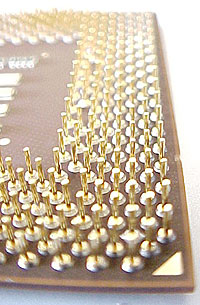This is more of a game benchmark, but since it tests DX7 we've included here as
well as in the sister review to this. The Pentium 4 doesn't stand up very well whatsoever
to the XP2000+.
3DMark2001 is the latest installment in the 3DMark
series by MadOnion. By combining DirectX8 support with completely new graphics,
it continues to provide good overall system benchmarks. 3DMark2001 has been
created in cooperation with the major 3D accelerator and processor manufacturers
to provide a reliable set of diagnostic tools. The suite demonstrates 3D gaming
performance by using real-world gaming technology to test a system's true
performance abilities. Tests include: DirectX8 Vertex Shaders, Pixel Shaders and
Point Sprites, DOT3 and Environment Mapped Bump Mapping, support for Full Scene
Anti-aliasing and Texture Compression and two game tests using Ipion real-time
physics. Higher 3DMark scores denote better performance.
| 3DMark 2001 Benchmark Results |
|
Processor |
3DMarks |
Ranking |
| 1. |
Athlon XP2000+ |
8026 |
 |
| 2. |
Pentium4 2.0GHz |
7617 |
 |
As 3DMark2001 is a DirectX8 benchmark, it
is much more intensive than the previous version. The Athlon processors
have traditionally enjoyed a lead in 3DMark scores and the Athlon XP2000+ is no
slacker. The benchmarks for both systems were a bit higher running under Windows XP,
but as most workstation class applications prefer Windows NT or Windows 2000 (in this case) the results are a bit lower.
Conclusions:
 AMD has really come a long way since the K6, K6-2 and 3 days which
saw underpowered CPU's teamed up with sub-par hardware leading to tons of compatibility and
stability problems. Even Intel, AMD's much bigger rival is having a hard
time keeping up in terms of performance with its much higher rated (in MHz
anyway) CPU's.
AMD has really come a long way since the K6, K6-2 and 3 days which
saw underpowered CPU's teamed up with sub-par hardware leading to tons of compatibility and
stability problems. Even Intel, AMD's much bigger rival is having a hard
time keeping up in terms of performance with its much higher rated (in MHz
anyway) CPU's.
Since this the
focus of this XP2000+ system review was the workstation, there no need to
dwell on overclockability or system level tweaks that most gamers constantly fawn
over.
The person doing digital video
editing, content for the internet, simple office applications like
Excel, or designing something in a CAD/CAM program is looking for two things
primarily - performance and 1005 reliability. A system that chockes on large spreadsheets,
humongous excel tables or complex wire frames is not going to improve the productivity of that
person.
Businesses, especially in this fiscally conservative
environment, require the least expenditure for the best performance and AMD is incredibly capable in this
regard. The Athlon XP 2000+, as with most gaming senarios is at par, or in most
cases, above par when squared off against the Pentium 4 2.0GHz in a DDR
system.
The
system we have looked at today is a great example of what "performance" hardware can do
when teamed up with such great processor. The Asus A7V266-E which is based on
VIA's KT266A chipset, 2x 256MB Corsair's extraordinary XMS PC2400 DDR and Asus's own
V8200 Ti500 Pure make this machine a force to be reckoned
with.
With the upcoming release of the Thoroughbred core (the .13 micron Athlon) and with
all the DDR333 based chip sets coming out, things can only get
better!
